Back Osteology Flashcards

mastoid process (multiple muscular attachments)

Mastoid Foramen (transmits Mastoid Emissary V. and Meningeal Branch of Occipital A.)

Styloid Process (origin for the Styloid muscles and ligament)

Stylomastoid Foramen

Mastoid Notch (medial to the Mastoid Process)

Mandibular Fossa (articulates with the Condylar Process of the Mandible at the Temporomandibular Joint)

External Occipital Protuberance (Inion)

Superior Nuchal Line (superior limit of the Neck, lateral extensions from the External Occipital Protuberance)

Inferior Nuchal Line (inferior to and less distinct than the Superior Nuchal line)

External Occipital Crest (inferior projection of the External Occipital Protuberance)

Pharyngeal Tubercle (central, anterior to Foramen Magnum, protrudes inferiorly, insertion for the Superior Pharyngeal Constrictor M.)

Occipital Condyle (paired on either side of Foramen Magnum, articulate with the Superior Articulating Process of the Atlas)

Condylar Canal (posterolateral to the Occipital Condyle)

Temporal B. (Squamous Part)

Temporal B. (Petrous Part)

Temporal B. (Mastoid Part)

Occipital B. (Squamous Part (External))

Occipital B. (Basilar Part (External))
Atlas (C1)

Anterior Arch
Atlas (C1)

Posterior Arch
Atlas (C1)

Lateral Mass
Atlas (C1)

Groove for the Verterbral artery
Atlas (C1)

Superior Articulating Process (articulates with Occipital Condyles)
Atlas (C1)

Transverse Foramen (transmits Vertebral artery)
Atlas (C1)

Fovea/Facet for Odontoid Process/Dens (houses the Odontoid Process/Dens of the Axis (C2))
Atlas (C1)

Anterior Tubercle (projects anteriorly)
Atlas (C1)

Posterior Tubercle (analagous to Spinous Process)
Atlas (C1)

Tubercle for Transverse Ligament (origin and contralateral insertion of Transverse band of Cruciform L.)
Atlas (C1)

Inferior Articulating Process (articulates with C2)
Atlas (C1)

Transverse Process
CN: A blow to the top of the head from a falling object or diving accident can fracture both arches of the Atlas. This fracture alone will not typically injure the Spinal Cord; however, if the Transverse Ligament is ruptured, the Odontoid Process may injure the Spinal Cord.

Jefferson or burst fracture
Axis (C2)

Odontoid Process (Dens; projects superiorly, fits into the Fovea for the Odontoid Process of the Atlas)
CN: The Axis is susceptible to fracture in primarily two places, the Odontoid Process and the Vertebral Arch. Fractures of the Vertebral Arch, or ________ _______, occurs usually as a result of hyperextension of the Head on the Neck (not of the Head and Neck as in whiplash)

Hangman’s Fracture
CN: This fracture may occur after a horizontal blow to the Head, and since the transverse ligament is stronger than the Odontoid Process, this fracture occurs. If the fracture occurs at the base of Dens, then it will usually not heal because the Transverse L. is holding it away from its blood supply. If the fracture occurs inferior to the base of the Dens within the vertebral body then it is much more likely to heal.

Odontoid Process (Dens) of Axis Fracture
C3-6

Vertebral Body (small and wide, superior surface concave, inferior surface convex)
C3-6

Uncinate Process (elevated superolateral margin of the Vertebral Body)
C3-6

Vertebral Foramen (transmits Spinal Cord, large and triangular)
C3-6

Vertebral Pedicle
C3-6

Vertebral Lamina
C3-6

Spinous Process (short and often bifid)
C3-6

Transverse Process
C3-6

Transverse Foramen (C1-6 transmits Vertebral A.)
C3-6

Posterior Tubercle (attachment point for Levator Scapulae muscles and Scalene muscles)
C3-6

Anterior Tubercle (attachment point for Levator Scapulae muscles and Scalene muscles, on C6 the Anterior Tubercle is called the Carotid Tubercle)
C3-6

Costotransverse Bar (lateral boundary of the Transverse Foramen, links the Costal and Transverse Elements of the Transverse Process, possesses a depressed area that accommodates the Anterior Rami of Spinal Nerves)
C3-6

Superior Articulating Process - Articulating Facet (articulates with the Inferior Articulating Process of the Vertebral segment above)
C3-6

Inferior Articulating Process - Articulating Facet (articulates with the Superior Articulating Process of the Vertebral segment below)
Vertebra Prominens (C7)

Spinous Process (long and well pronounced)
A bony defect that occurs in 24% of the population, refers to a developmental abnormality in which the Vertebral Lamina fail to fuse and close off the Vertebral Canal. This condition commonly occurs at L5 and S1, where it can go undetected due to the overlying skin. Often a tuft of hair exists over the defect. If the condition also incorporates neural tissue and Meninges, it is referred to as Spina Bifida ______

- Spina Bifida Occulta (mildest form)
- Spina Bifida Cystica (more severe form)
Since the Articulating Facets of Cervical Vertebrae are more horizontal than the other Vertebrae, it requires less force to dislocate the Cervical Vertebrae; however, due to the large Vertebral Foramen this does not usally result in injury to the Spinal Cord. Severe dislocations, or dislocations combined with fractures (fracture–dislocations), injure the Spinal Cord.

Cervical Vertebrae Dislocation
T1-12

Superior Costal Facet (meets with the Costal Head of the same numeric segment)
T1-12

Inferior Costal Facet (meets with the Costal Head one numeric segment up)
T1-12

Vertebral Foramen (small, round, transmits Spinal Cord)
T1-12

Vertebral Pedicle
T1-12

Vertebral Body (heart shaped, articulates with 12 ribs)
T1-12

Lamina (well pronounced in the superior to inferior direction)
T1-12

Spinous Process (protrude predominantly inferiorly)
T1-12

Transverse Process - Transverse Costal Facet (meets with the Costal Tubercle of the same numeric segment)
T1-12

Superior Articulating Process - Articular Facet (articulates with the Inferior Articular Process of the Vertebral Segment above)
T1-12

Inferior Articular Process - Articular Facet (articulates with the Superior Articular Process of the Vertebral segment below)
A degenerative joint disease which involves calcification of the edges of the verbebral body and can cause localized pain and stiffness. Separation of the Vertebra Arch from the Vertebral Body is a condition known as ________. Anterior displacement of the Vertebral Body on the Inferior Vertebral Segment is known as ___________, which can occur secondarily to Spondylosis.

- Spondylosis
- Spondylolisthesis
Typical Ribs (3-9)

Costal Head (articulates with the Thoracic Vertebrae)
Typical Ribs (3-9)

Superior Articular Facet (articulates with Inferior Costal Demifacet on Thoracic Vertebral Body one numeric segment superiorly)
Typical Ribs (3-9)

Inferior Articular Facet (articulates with the Superior Costal Demifacet on Thoracic Vertebral Body of the same numberic segment)
Typical Ribs (3-9)

Crest of the Head (separates the two Articular Facets)
Typical Ribs (3-9)

Costal Neck (stretch of bone between Head and Tubercle)
Typical Ribs (3-9)

Costal Tubercle (possesses an Articular Part with an Articular Facet and a Nonarticular Part that is the attachment point for the Lateral Costotransverse L.)
Typical ribs (3-9)

Articular Facet (articulates with Transverse Costal Facets on Thoracic Vertebrae)
Typical Ribs (3-9)

Costal Groove (houses Intercostal nerve and vessels)
Typical Ribs (3-9)
*study this photo for ribs*

Costal Angle (anterolateral turning point of the Rib)
Typical Ribs (3-9)
*study this photo for ribs*

Costal Body (shaft)
Lumbar Vertebrae (5)

Vertebral Body (very large and kidney shaped)
Lumbar Vertebrae (5)

Vertebral Foramen (transmits Spinal Cord, Conus Medullaris, and Cauda Equina, large and triangular)
Lumbar Vertebrae (5)

Spinous Process (short, sturdy, and hatchet shaped)
Lumbar Vertebrae (5)

Transverse Process (long and slender)
Lumbar Vertebrae (5)

Accessory Process (at the base of the Transverse Process, attachment for the Intertransversarii muscles)
Lumbar Vertebrae (5)

Superior Articulating Process (articulates with the Inferior Articulating Process of the Vertebral segment below)
Lumbar Vertebrae (5)

Superior Articulating Facet
Lumbar Vertebrae (5)

Mamillary Process (unique to Lumbar Vertebrae, attachment for Multifidi muscles and Intertransversarii muscles)
Lumbar Vertebrae (5)

Inferior Articulating Process (articulates with the Superior Articulating Process of the Vertebral segment below)
Lumbar Vertebrae (5)

Inferior Articulating Facet
Narrowing of Lumbar Vertebral Foramen. May cause compression of one or more Spinal Nerve Roots. When this condition is further compounded with Intervertebral Disc bulging, Arthritic Proliferation and Ligamentous Degeneration, the Vertebral Canal is considerably more compromised.

Lumbar Spinal Stenosis
An important diagnostic procedure for evaluating a variety of central nervous system disorders. A needle is inserted between either the L3/L4 vertebrae or L4/L5 vertebrae at the level of iliac crests. This level is typically chosen to avoid the needle injuring the spinal cord. As the needle passes through the ligamentum flavum it “pops” and passes into the lumbar cistern deep to the spinal dura and arachnoid mater. Cerebrospinal fluid can then be drawn out and evaluated.

Lumbar Puncture (spinal tap)
Sacrum (5 fused vertebrae)

Superior Articulating Process (projects superiorly, articulates with Inferior Articulating Process of L5)
Sacrum (5 fused vertebrae)

Base (superior surface of S1)
Sacrum (5 fused vertebrae)
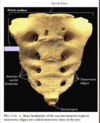
Sacral Ala (projects laterally)
Sacrum (5 fused vertebrae)

Articular Surface of Sacrum (articulates with the Articular Surface of the Ilium)
Sacrum (5 fused vertebrae)

Sacral Promontory (anteriorly projecting edge of the Vertebral Body of S1, sacral contribution to the Pelvic Brim)
Sacrum (5 fused vertebrae)

Vertebral Body of S1 (articulates with Vertebral Body of L5)
Fusion of Sacrum and L5 Vertebra. Lumbarization is the opposite, which is the separation of the S1 Vertebra from the Sacrum

Sacralization
Sacrum (5 fused vertebrae)

Median Sacral Crest (fused Spinous Processes)
Sacrum (5 fused vertebrae)
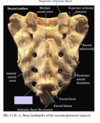
Intermediate Sacral Crest (fused Articulating Processes)
Sacrum (5 fused vertebrae)

Lateral Sacral Crest (fused Transverse Processes)
Sacrum (5 fused vertebrae)

Sacral Tuberosity (lateral to the Lateral Sacral Crest, forms the fibrous articulation with the Iliac Tuberosity)
Sacrum (5 fused vertebrae)

Posterior Sacral Foramina (smaller than Anterior Sacral Foramina, transmit Posterior Ramus of Sacral Spinal nerves)
Sacrum (5 fused vertebrae)
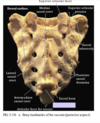
Sacral Hiatus (resultant gap left by absence of Lamina and Spinous Process of S5)
Sacrum (5 fused vertebrae)
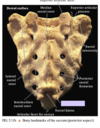
Sacral Cornua - Sacral Horn (project inferiorly, Inferior Articulating Processes of S5)
Sacrum (5 fused vertebrae)
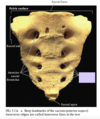
Transverse Lines/Ridges (4, represent fusion of Sacral Vertebrae)
Sacrum (5 fused vertebrae)

Anterior Sacral Foramina (larger than Posterior Sacral Foramina, transmit Anterior Ramus of Sacral Spinal nerves)
Sacrum (5 fused vertebrae)

Sacral Apex (narrow inferior end)
Sacrum (5 fused vertebrae)

Sacral Articular Facet for Coccyx
Sacrum (5 fused vertebrae)

Sacral Canal (continuation of Vertebral Foramina, transmits Cauda Equina)
Coccyx (3-5 fused vertebrae, embryological remnant)

Coccygeal Cornua (articulate with Sacral Cornua)
Coccyx (3-5 fused vertebrae, embryological remnant)

Transverse Process (present only on the superior most Coccygeal Segment)
Coccyx (3-5 fused vertebrae, embryological remnant)

Tip of the Coccyx (inferior projection)
Abrupt falls on the lower back and difficult child birth can result in bruising, dislocation, or fracture of the Coccyx, Coccygodynia can follow coccygeal trauma, it is painful and difficult to treat.

Coccyx Fracture
The vertebral column is described as having Primary and Secondary curvatures. The primary curvatures are the Thoracic and Sacral _______, the Secondary curvatures are the Cervical and Lumbar _______, as they result from extension from the Fetal Position.

- Kyphoses
- Lordoses
Abnormal curvatures of the spine are similarly named to the curvature they represent. _______ refers to exaggerated curving of the Thoracic Vertebral Column resulting in “hump-back.” _______ refers to exaggerated curving of the Lumbar Vertebral Column resulting in “sway-back.” _______ refers to lateral curving of the spine, either to the right of left.

- Kyphosis
- Lordosis
- Scoliosis


